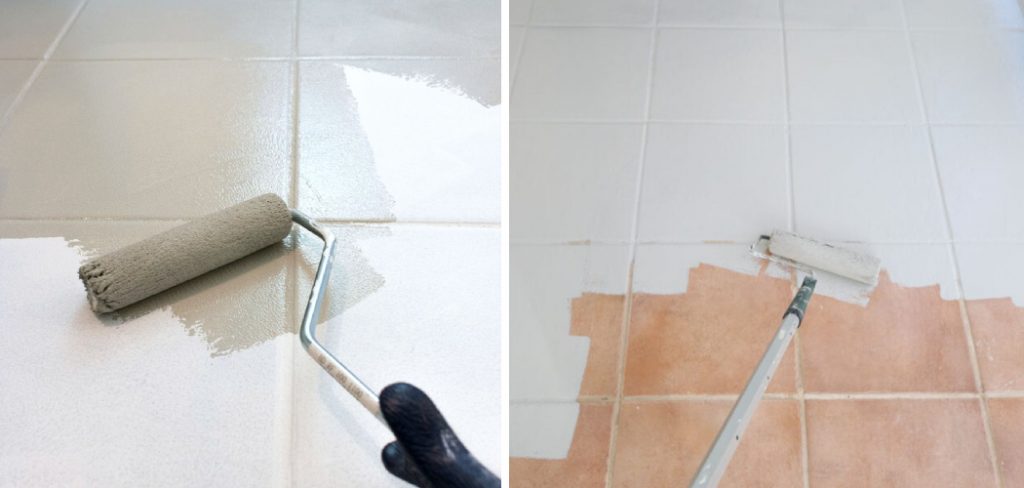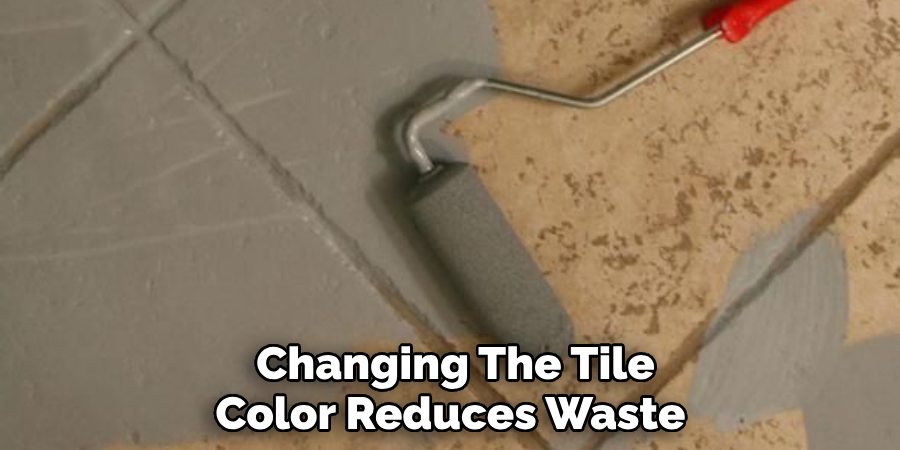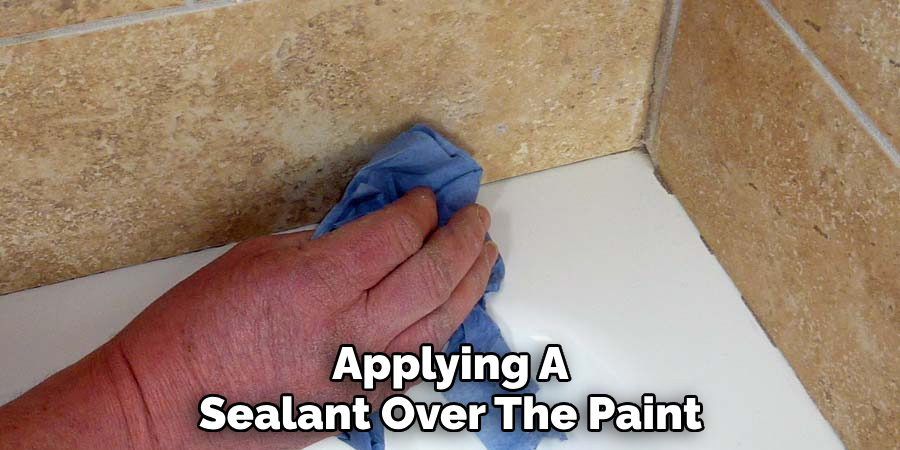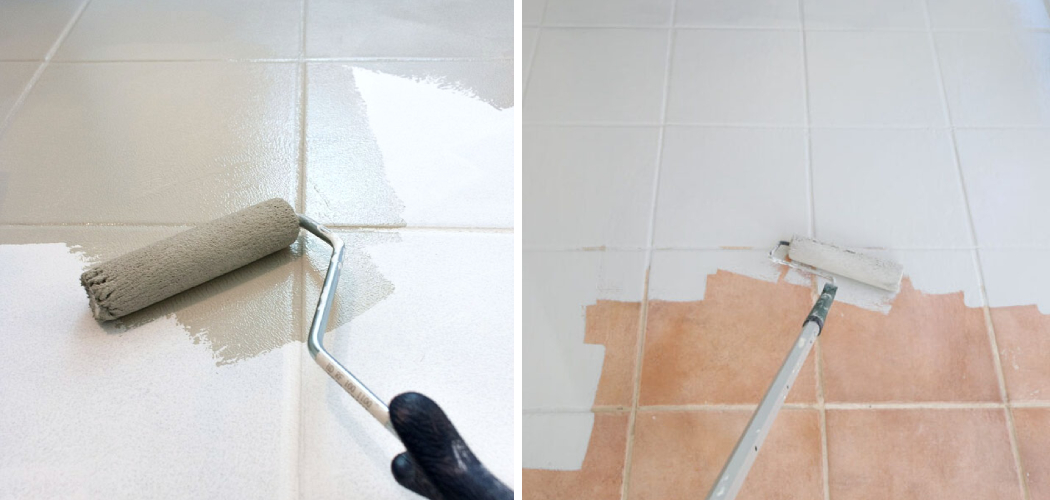Changing floor tile color can be a daunting and expensive task, especially if you have to replace all your tiles. However, there are a few alternatives that can help you achieve the desired result without having to entirely replace your floor tiles. In this article, we will discuss to change floor tile color without replacing them and why it may be a better option for you.

Changing the color of floor tiles is a great way to update the look and feel of a room without having to undergo the hassle and expense of completely replacing them.
Whether you want to change the color because it no longer matches your decor or simply want a fresh new look, there are several advantages to learning to change floor tile color without replacing them. In this blog post, You will learn in detail how to change floor tile color without replacing.
Step by Step Processes for How to Change Floor Tile Color Without Replacing
Step 1: Inspect the Current Tiles
Before you start changing the color of your floor tiles, it’s essential to inspect the current condition and material of your tiles. Different materials may require different techniques and products for coloring.
Step 2: Clean the Tiles
To ensure a smooth and even application of color, it is crucial to thoroughly clean your tiles. Use a mild cleaner or warm water with a scrub brush to remove any dirt, grime, or stains from the surface. If your tiles have a glossy finish or are made of natural stone, you will need to sand them lightly before proceeding with coloring. This step helps roughen up the surface and create a better bond for the color.
Step 3: Protect Surrounding Areas
Before applying any color, it’s essential to protect the surrounding areas, such as walls and cabinets, from overspray or spills. Use painter’s tape and plastic sheeting to cover these areas. There are various options for coloring your floor tiles, including tile paint, epoxy coatings, and stain. Consider the material of your tiles and your desired color before choosing the best product for your project.

Step 4: Apply Primer (If Required)
Some tile paints or coatings may require a primer to ensure proper adhesion and durability. Follow the manufacturer’s instructions for applying the primer and let it dry completely before proceeding.
If you are using a stain or epoxy coating, you will need to mix the colors according to the manufacturer’s instructions. Make sure to follow the correct ratio and thoroughly blend the components for an even color.
Step 5: Apply Color
Using a paintbrush or roller, apply your chosen color evenly on the tiles. Start from a corner and work your way towards the exit to avoid stepping on wet areas. Follow the recommended number of coats for your chosen product. After applying the color, allow it to dry completely before walking on or replacing furniture on the tiles. This step is crucial for achieving a durable and long-lasting finish.
To protect your newly colored tiles from daily wear and tear, you can apply a sealant on top of the color. This step is optional but recommended for high-traffic areas. Now that you know the step-by-step process for changing floor tile color without replacing them, you can give your old tiles a fresh new look without breaking the bank. Remember to always follow safety precautions and carefully read product instructions before starting any DIY project.

Safety Tips for How to Change Floor Tile Color Without Replacing
- When working with chemicals and other materials, it is important to wear the proper safety equipment such as gloves, goggles, and a respirator mask. This will help protect your skin, eyes, and lungs from any potential harm.
- Before starting the process of changing floor tile color without replacing them, make sure to open windows and provide proper ventilation in the room. This will prevent any harmful fumes from accumulating and causing health risks.
- Take time to carefully read and follow the instructions on all materials being used, especially when it comes to mixing chemicals or using a special type of primer or paint. Improper use can result in dangerous reactions or ineffective results.
- It is important to properly prepare the surface of your floor tiles before applying any color. This may include cleaning, sanding, and priming to ensure a smooth and even finish.
- Always work in a well-lit area to avoid making mistakes or missing spots. Good lighting will also make it easier to see if the new color is being applied evenly.
- Keep children and pets away from the work area to prevent any accidents or ingestion of harmful chemicals. It is also important to store all materials and tools out of reach when not in use.
- After completing the process, make sure to properly dispose of any leftover materials and clean up the work area thoroughly. This will help keep your home safe and free from potential hazards.

Remember, while changing floor tile color without replacing them may seem like a simple and cost-effective solution, it should still be approached with caution and following these safety tips will ensure a successful and safe outcome.
What Are the Benefits of Changing Floor Tile Color Without Replacing Them?
Floor tiles are a common flooring option in homes and commercial spaces due to their durability, low maintenance, and aesthetic appeal. However, as time goes by, the color of floor tiles can start to fade or become outdated. This often leads to the dilemma of whether to replace the entire floor or simply change the tile color.
Fortunately, there is an alternative solution – changing the floor tile color without replacing them. Not only does this save time and money, but it also has several other benefits.
1. Cost-Effective
Replacing floor tiles can be a costly project as it involves the removal of existing tiles and installation of new ones. Additionally, there may be additional costs such as hiring professionals and purchasing new materials. On the other hand, changing the tile color is a much more affordable option. It requires minimal materials and can often be done as a DIY project, saving you money on labor costs.
2. Time-Efficient
Replacing floor tiles is a time-consuming process that can disrupt your daily routine and cause inconvenience. On the contrary, changing the tile color can be done within a shorter period, depending on the size of the floor. This is especially beneficial for commercial spaces, where time is of the essence and minimizing disruptions is crucial.
3. Versatile Option
Changing the tile color allows you to customize your flooring and create a unique look that suits your style and preferences. Unlike replacing tiles, which limits you to the available options in the market, changing the color gives you endless possibilities. You can choose to paint the tiles or use a color stain to achieve your desired look.
4. Eco-Friendly
Replacing floor tiles means disposing of the old ones, which can contribute to environmental waste. On the other hand, changing the tile color reduces waste and is more eco-friendly. It also eliminates the need for new materials, conserving natural resources.

5. Easy Maintenance
Maintaining colored floor tiles is relatively easy compared to other flooring options. Regular cleaning and occasional touch-ups can help keep the tiles looking vibrant and new. On the other hand, replacing tiles may require more intensive maintenance, such as sealing and polishing.
In conclusion, changing the floor tile color without replacing them not only saves time and money but also offers several other benefits. It’s a versatile and cost-effective solution that allows you to customize your flooring and contribute to a more sustainable environment.
Are There Any Limitations or Risks Associated With Changing Floor Tile Color Without Replacing?
One of the main reasons why people consider changing the color of their floor tiles without replacing them is to save time and money. However, it’s important to understand that there are certain limitations and risks associated with this process.
The first limitation to consider is the existing color of your floor tiles. If you want to change from a dark color to a lighter one, it may take multiple coats of paint to achieve the desired shade. This can be time-consuming and may end up costing more in terms of paint and labor.
Another limitation is the type of tile you have. Ceramic and porcelain tiles are ideal for painting, but other materials like stone or vinyl may not hold the paint as well or may require specific primers for better adhesion. Moreover, changing the color of your floor tiles without replacing them can also pose some risks. The process may cause damage to the tiles, especially if they are old or already have cracks or chips.
How Do You Properly Clean and Maintain the Tiles After Changing Their Color?
Proper maintenance and cleaning are crucial to ensuring the longevity of your newly painted floor tiles. First, make sure to regularly sweep or vacuum the area to remove any dirt or debris that can scratch the paint. Use a non-abrasive cleaner specifically designed for painted surfaces to avoid damaging the color.
If you notice any stains or spills, clean them immediately with a mild soap and water solution. Avoid using harsh chemicals or abrasive cleaners as they can strip off the paint or cause discoloration. It’s also important to avoid dragging heavy furniture or sharp objects on the painted floor tiles.
Regularly applying a sealant over the paint can help protect it from wear and tear, especially in high traffic areas. Additionally, avoid excessive moisture exposure as it can cause the paint to peel off or discolor.

Use rugs or mats in areas prone to moisture, such as near sinks or showers. Lastly, periodically inspect the painted floor tiles for any signs of wear or damage. If you notice any chips, scratches, or fading, it may be time to do touch-ups or consider replacing the tiles altogether.
Conclusion
In conclusion, changing the color of your floor tiles without having to replace them is a cost-effective and time-saving solution for those looking to update their home’s aesthetic. By following the steps outlined in this guide, you can easily transform the look of your floors without going through the hassle and expense of replacing them entirely.
Furthermore, changing the color of your floor tiles can also give you more flexibility in terms of design and style choices. You can easily match them with your existing decor or experiment with different color combinations to achieve a unique look. I hope this article has been beneficial for learning how to change floor tile color without replacing. Make Sure the precautionary measures are followed chronologically.
